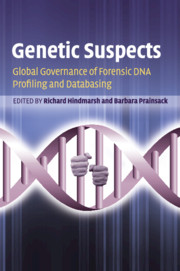Book contents
- Frontmatter
- Contents
- List of contributors
- About the contributors
- Foreword
- Acknowledgements
- 1 Introducing Genetic Suspects
- Section 1 Key areas in DNA profiling and databasing
- 2 Key issues in DNA profiling and databasing: implications for governance
- 3 Forensic utilization of voluntarily collected DNA samples: law enforcement versus human rights
- 4 Base assumptions? Racial aspects of US DNA forensics
- 5 Health and wealth, law and order: banking DNA against disease and crime
- 6 DNA profiling versus fingerprint evidence: more of the same?
- Section 2 National contexts of forensic DNA technologies and key issues
- Section 3 Conclusions
- Index
- References
3 - Forensic utilization of voluntarily collected DNA samples: law enforcement versus human rights
from Section 1 - Key areas in DNA profiling and databasing
Published online by Cambridge University Press: 05 October 2012
- Frontmatter
- Contents
- List of contributors
- About the contributors
- Foreword
- Acknowledgements
- 1 Introducing Genetic Suspects
- Section 1 Key areas in DNA profiling and databasing
- 2 Key issues in DNA profiling and databasing: implications for governance
- 3 Forensic utilization of voluntarily collected DNA samples: law enforcement versus human rights
- 4 Base assumptions? Racial aspects of US DNA forensics
- 5 Health and wealth, law and order: banking DNA against disease and crime
- 6 DNA profiling versus fingerprint evidence: more of the same?
- Section 2 National contexts of forensic DNA technologies and key issues
- Section 3 Conclusions
- Index
- References
Summary
INTRODUCTION
Forensic DNA profiling is now an indispensable tool used by law enforcement agencies worldwide. Since its introduction by Sir Alec Jeffries and colleagues (Gill et al. 1985), forensic DNA has caused a revolution in crime scene investigation, similar to that brought about by fingerprint identification capabilities a century ago (see Chapter 6). The annual number of cases solved by means of DNA profiling in the UK, for example, is now approaching the number of those solved with the use of fingerprints. Nevertheless, the DNA profiling ‘revolution’ would not have occurred without the emergence of computerised forensic databases. Among those databases that focus on individual characteristics, the automated fingerprint identification systems and DNA databases are most valuable for law enforcement authorities. They allow the generation of ‘cold hits’, namely the identification of a suspect without a classical criminal investigation. The combination of two parallel processes – scientific innovations in the field of molecular genetics and the emergence of computerised databases – underpins contemporary methodology of forensic investigation.
Scientifically, forensic DNA profiling is still considered a young technology. It is also a relatively complicated process, prone to contaminations and misinterpretations. Its probabilistic nature leaves much room for debates regarding interpretation (see also Chapters 2, 6 and 7). Other controversies connected to DNA profiling and databasing involve ethical and legislative issues. Privacy and human rights issues are weighed generally against the well-being of society, but no clear lines can be drawn as in many instances they are complementary (Etzioni 2004).
- Type
- Chapter
- Information
- Genetic SuspectsGlobal Governance of Forensic DNA Profiling and Databasing, pp. 40 - 62Publisher: Cambridge University PressPrint publication year: 2010
References
- 3
- Cited by



